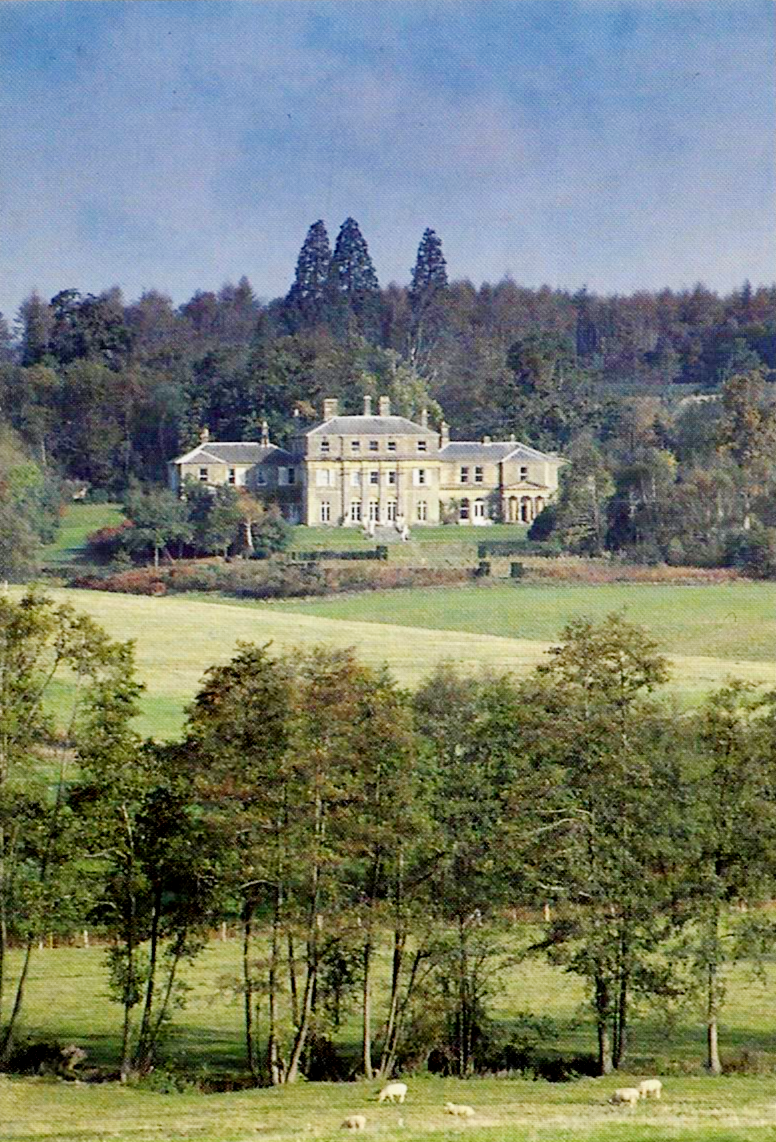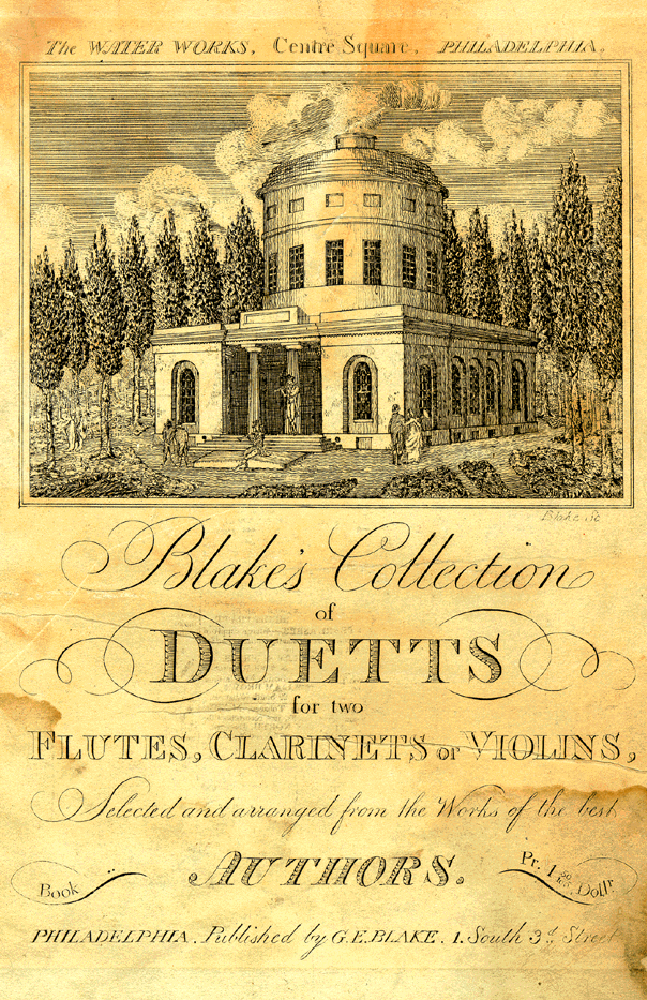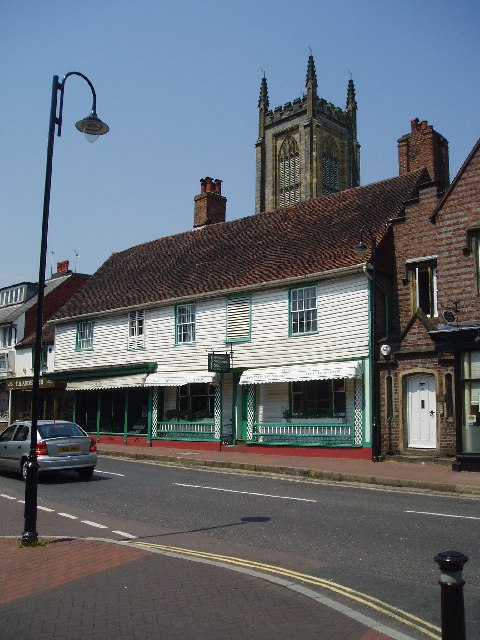|
Hammerwood
Hammerwood is a hamlet in the civil parish of Forest Row in East Sussex, England. Its nearest town is East Grinstead, which lies approximately west from the village. The village is situated on the High Weald, on the East Sussex-West Sussex-Kent-Surrey border. History Early history The village's name is derived from connections to the Wealden iron industry, and a reference to the hammer used in the furnace of the iron forge. A Romano-British iron bloomery (now listed as a site of historic interest) was located near the ponds to the south-east of where the modern village – which did not exist at the time – is located, and a blast furnace existed on another site nearby from at least the 1500s. Areas of nearby woodland are similarly named, including Hammer Wood, Cansiron Wood and Cinder Wood. The settlement was, for several centuries, the central part of an estate known as The Bower, and is believed to have comprised part of a medieval deer park. Development In 1792, a site t ... [...More Info...] [...Related Items...] OR: [Wikipedia] [Google] [Baidu] |
Hammerwood Park
Hammerwood Park is a country house in Hammerwood, near East Grinstead, in East Sussex, England. It is a Grade I listed building. One of the first houses in England to be built in the Greek Revival architectural style, it was built in 1792 as the first independent work of Benjamin Henry Latrobe. Described by Nikolaus Pevsner as a 'demonstration of primeval force', the house was owned by Led Zeppelin from 1973 until 1982. History The site before 1792 The land previously comprised part of a previous estate known as The Bower, probably named after a family called Atte Boure, who are listed as paying tax to Edward I in the 1290s, a substantial landholding which included parts of the parishes of East Grinstead and Hartfield. Sometime during the 1500s the owners, the Botting family, founded an iron forge to the east of the ponds in the valley to the south of the current house (coordinates: ). The forge may have been in existence in 1558, when Hugh Botting left "two tons of yron" ... [...More Info...] [...Related Items...] OR: [Wikipedia] [Google] [Baidu] |
Hartfield
Hartfield is a village and civil parish in the Wealden district of East Sussex, England. The parish also includes the settlements of Colemans Hatch, Hammerwood and Holtye, all lying on the northern edge of Ashdown Forest. Geography The main village of Hartfield lies seven miles (11.2 km) south-west of Royal Tunbridge Wells where the B2110 road between Groombridge and Forest Row meets the B2026 road between Edenbridge and Maresfield. Governance Hartfield Parish Council consists of 13 members. The population of this ward as taken at the 2011 census was 2,639. The parish settlements Hartfield is the main village in the parish. The church is dedicated to St Mary the Virgin. There are three public houses: ''Anchor Inn''; ''Gallipot Inn''; and ''Haywagon Inn''. The village street is narrow, precluding much parking although The Anchor and Haywagon Inns have private car parks for patrons only. Note that the Haywagon Inn closed in 2015 following a planning application to ... [...More Info...] [...Related Items...] OR: [Wikipedia] [Google] [Baidu] |
Benjamin Henry Latrobe
Benjamin Henry Boneval Latrobe (May 1, 1764 – September 3, 1820) was an Anglo-American neoclassical architect who emigrated to the United States. He was one of the first formally trained, professional architects in the new United States, drawing on influences from his travels in Italy, as well as British and French Neoclassical architects such as Claude Nicolas Ledoux. In his thirties, he emigrated to the new United States and designed the United States Capitol, on " Capitol Hill" in Washington, D.C., as well as the Old Baltimore Cathedral or The Baltimore Basilica, (later renamed the Basilica of the National Shrine of the Assumption of the Blessed Virgin Mary). It is the first Cathedral constructed in the United States for any Christian denomination. Latrobe also designed the largest structure in America at the time, the "Merchants' Exchange" in Baltimore. With extensive balconied atriums through the wings and a large central rotunda under a low dome which dominated the city ... [...More Info...] [...Related Items...] OR: [Wikipedia] [Google] [Baidu] |
East Grinstead
East Grinstead is a town in West Sussex, England, near the East Sussex, Surrey, and Kent borders, south of London, northeast of Brighton, and northeast of the county town of Chichester. Situated in the extreme northeast of the county, the civil parish has an area of . The population at the 2011 Census was 26,383. Nearby towns include Crawley and Horley to the west, Tunbridge Wells to the east and Redhill and Reigate to the northwest. The town is contiguous with the village of Felbridge to the northwest. Until 1974 East Grinstead was in East Sussex, before joining together with Haywards Heath and Burgess Hill as the Mid-Sussex district of West Sussex. The town is on the Greenwich Meridian. It has many historic buildings, and the Weald and Ashdown Forest lie to the south-east. Places of interest The High Street contains one of the longest continuous runs of 14th-century timber-framed buildings in England. Other notable buildings in the town include Sackville College, the san ... [...More Info...] [...Related Items...] OR: [Wikipedia] [Google] [Baidu] |
East Sussex
East Sussex is a ceremonial and non-metropolitan county in South East England on the English Channel coast. It is bordered by Kent to the north and east, West Sussex to the west, and Surrey to the north-west. The largest settlement in East Sussex is the city of Brighton and Hove. History East Sussex is part of the historic county of Sussex, which has its roots in the ancient kingdom of the South Saxons, who established themselves there in the 5th century AD, after the departure of the Romans. Archaeological remains are plentiful, especially in the upland areas. The area's position on the coast has also meant that there were many invaders, including the Romans and later the Normans. Earlier industries have included fishing, iron-making, and the wool trade, all of which have declined, or been lost completely. Governance Sussex was historically sub-divided into six rapes. From the 12th century the three eastern rapes together and the three western rapes together had separ ... [...More Info...] [...Related Items...] OR: [Wikipedia] [Google] [Baidu] |
Greek Revival
The Greek Revival was an architectural movement which began in the middle of the 18th century but which particularly flourished in the late 18th and early 19th centuries, predominantly in northern Europe and the United States and Canada, but also in Greece itself following independence in 1832. It revived many aspects of the forms and styles of ancient Greek architecture, in particular the Greek temple, with varying degrees of thoroughness and consistency. A product of Hellenism, it may be looked upon as the last phase in the development of Neoclassical architecture, which had for long mainly drawn from Roman architecture. The term was first used by Charles Robert Cockerell in a lecture he gave as Professor of Architecture to the Royal Academy of Arts, London in 1842. With a newfound access to Greece and Turkey, or initially to the books produced by the few who had visited the sites, archaeologist-architects of the period studied the Doric and Ionic orders. Despite its uni ... [...More Info...] [...Related Items...] OR: [Wikipedia] [Google] [Baidu] |
Wealden (UK Parliament Constituency)
Wealden is a constituency represented in the House of Commons of the UK Parliament since 2015 by Nus Ghani, a Conservative. Ghani is the first Muslim woman to be elected as a Conservative member of Parliament. History This seat was created in the third periodic review of constituencies in 1983, from a mixture of the previous Mid and Northern divisions of East Sussex (also known as Lewes and East Grinstead). ;Political history The seat's history is that of a safe Conservative seat. Before the 2015 election, the Liberal Democrats, including their two predecessor parties, were represented by the main opposition candidate, but they then fell to fourth place. The best result for the Labour Party was in 2017, though it was 39% below the winning vote share. ;Prominent frontbenchers Locally born Charles Hendry served as a Minister of State in the Department of Energy and Climate Change from 2010 to 2012 following two years in the shadow role in opposition. Boundaries 1983–1997: ... [...More Info...] [...Related Items...] OR: [Wikipedia] [Google] [Baidu] |
Deer Park (England)
In medieval and Early Modern England, Wales and Ireland, a deer park () was an enclosed area containing deer. It was bounded by a ditch and bank with a wooden park pale on top of the bank, or by a stone or brick wall. The ditch was on the inside increasing the effective height. Some parks had deer " leaps", where there was an external ramp and the inner ditch was constructed on a grander scale, thus allowing deer to enter the park but preventing them from leaving. History Some deer parks were established in the Anglo-Saxon era and are mentioned in Anglo-Saxon Charters; these were often called ''hays'' (from Old English ''heġe'' (“hedge, fence”) and ''ġehæġ'' (“an enclosed piece of land”). After the Norman conquest of England in 1066 William the Conqueror seized existing game reserves. Deer parks flourished and proliferated under the Normans, forming a forerunner of the deer parks that became popular among England's landed gentry. The Domesday Book of 1086 record ... [...More Info...] [...Related Items...] OR: [Wikipedia] [Google] [Baidu] |
St Mary Magdalene
Mary Magdalene (sometimes called Mary of Magdala, or simply the Magdalene or the Madeleine) was a woman who, according to the four canonical gospels, traveled with Jesus as one of his followers and was a witness to his crucifixion and resurrection. She is mentioned by name twelve times in the canonical gospels, more than most of the apostles and more than any other woman in the gospels, other than Jesus' family. Mary's epithet ''Magdalene'' may mean that she came from the town of Magdala, a fishing town on the western shore of the Sea of Galilee in Roman Judea. The Gospel of Luke chapter 8 lists Mary Magdalene as one of the women who traveled with Jesus and helped support his ministry "out of their resources", indicating that she was probably wealthy. The same passage also states that seven demons had been driven out of her, a statement which is repeated in Mark 16. In all the four canonical gospels, Mary Magdalene was a witness to the crucifixion of Jesus and, in the Syno ... [...More Info...] [...Related Items...] OR: [Wikipedia] [Google] [Baidu] |
First World War
World War I (28 July 1914 11 November 1918), often abbreviated as WWI, was one of the deadliest global conflicts in history. Belligerents included much of Europe, the Russian Empire, the United States, and the Ottoman Empire, with fighting occurring throughout Europe, the Middle East, Africa, the Pacific, and parts of Asia. An estimated 9 million soldiers were killed in combat, plus another 23 million wounded, while 5 million civilians died as a result of military action, hunger, and disease. Millions more died in genocides within the Ottoman Empire and in the 1918 influenza pandemic, which was exacerbated by the movement of combatants during the war. Prior to 1914, the European great powers were divided between the Triple Entente (comprising France, Russia, and Britain) and the Triple Alliance (containing Germany, Austria-Hungary, and Italy). Tensions in the Balkans came to a head on 28 June 1914, following the assassination of Archduke Franz Ferdina ... [...More Info...] [...Related Items...] OR: [Wikipedia] [Google] [Baidu] |
Ecclesiastical Parish
A parish is a territorial entity in many Christianity, Christian denominations, constituting a division within a diocese. A parish is under the pastoral care and clerical jurisdiction of a priest#Christianity, priest, often termed a parish priest, who might be assisted by one or more curates, and who operates from a parish church. Historically, a parish often covered the same geographical area as a Manorialism, manor. Its association with the parish church remains paramount. By extension the term ''parish'' refers not only to the territorial entity but to the people of its community or congregation as well as to church property within it. In England this church property was technically in ownership of the parish priest ''Ex officio member, ex-officio'', vested in him on his institution to that parish. Etymology and use First attested in English in the late, 13th century, the word ''parish'' comes from the Old French ''paroisse'', in turn from la, paroecia, the Latinisation ... [...More Info...] [...Related Items...] OR: [Wikipedia] [Google] [Baidu] |







